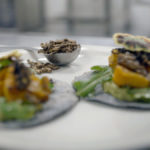If the experts are to be believed, 2023 may just be the breakthrough-year for seaweed.
Pinterest, for one, predicts that this year’s hottest superfoods will be from the sea. Long a staple of Asian cuisine, ocean-based foods such as green algae, nori and seaweed snacks are “trending up” among Millennials and Gen X. Specialty grocer Whole Foods Market, which each year publishes its own influential forecast of food and beverage trends, says kelp – a brownish seaweed, often spotted on beaches – will be lighting up aisles, in everything from noodles and chips to fish-free “fish” sauce. Not to mention, “kelp can absorb carbon in the atmosphere, making kelp farming more important than ever in the age of climate consciousness,” Whole Foods adds.
All of this is welcome news to the Maine-based Atlantic Sea Farms, the first commercial seaweed farm in the U.S. that estimates it produces 80% of seaweed cultivated here. “There’s a lot of really good buzz about seaweed and kelp right now,” says Briana Warner, its CEO, who just returned from a December trip to the Faroe Islands to meet seaweed-growing colleagues there (kelp loves cold water). “People are becoming more and more aware of the benefits to their health and the environment, but also how good it tastes.”
It’s been a long road for U.S. consumers to embrace seaweed, even though sushi lovers have been eating it since the ’90s in rolls and the ubiquitous “seaweed salad” at Japanese restaurants. But right now, seaweed pulls together the health-conscious, climate-concerned and epicurean-minded in a sort of Venn diagram of current superfood trends.
Fast-growing kelp helps clean the ocean, and compared with terrestrial plants and animal meats, is loaded with digestive and nutritional benefits. Yet 95% of edible seaweed is imported – something Atlantic Sea Farms is on a mission to change. The company makes fermented seaweed salad, along with kelp cubes (for smoothies), kimchi and kraut, and has just released sea-veggie burgers. And it sells whole-leaf kelp to chefs. When talking to restaurants, Warner says she simply focuses on taste, suggesting to wrap kelp around fish or mix into dishes. “It adds a deeper umami,” she says.
An economist by training, Warner became Atlantic Sea Farms’ CEO in 2018 after a stint at the Maine-based nonprofit Island Institute. (The farm originally began in 2009 under the name Ocean Approved.) She has overseen an expansion, partnering with dozens of Maine lobster farmers to grow and harvest kelp in their offseason, which helps diversify their income. It’s a cooperative farming model similar to those used by Stonyfield Organic for milk and Ocean Spray for cranberries. Kelp farming “uses the exact same equipment as lobstering does,” plus lobster farmers already have a “massive skill set” on the sea, she says. (Watch the video to see how line-grown kelp is extracted from the ocean.)
The company’s growth – in the midst of a pandemic – has been impressive. In 2021, Atlantic Sea Farms raised $4.7 million in funding, built out a 27,000-square-foot processing facility in Biddleford, and harvested 675,000 pounds of kelp (it now expects over a million pounds a year). Its products are sold in over 2,000 locations, including grocery chains Sprouts, Wegmans and Whole Foods.
Warner, who moved to the state about eight years ago after marrying her Mainer husband, Matt, is an unabashed kelp enthusiast. “It’s the best possible food that you can eat,” she says. “Kelp is loaded with calcium, magnesium and iodine.” But the impact on the ocean – a particular concern, given that the Gulf of Maine is warming each year – is a driving force. “Kelp can also help mitigate some of the effects of climate change by removing carbon and nitrogen from the water,” she says. “It’s this amazing product to grow.”
The buzz, in fact, can be a bit much. The New York Times has written about efforts to make kelp the next kale – that is, the superfood that leapt from salad-bar garnish to chef’s table darling, seemingly overnight. And some have likened kelp to the “soy of the sea” for its ability to be processed into a wide variety of food and possibly biofuels.
Warner isn’t fond of any of the comparisons. Both kale and soy require an enormous amount of water, arable land and pesticides. “Terrestrial farming has made farmers poor, the environment worse, and customers less happy,” she says. Kelp, on the other hand, is a regenerative crop. “I don’t want to compare it to anything out there.”
Aquaculture in general seems to be the way of the future. In 2021, the U.N. noted that oceans cover more than 70 percent of the earth, yet contribute only 2 percent of the world’s food. The organization called seaweed the “greatest untapped resource on the planet.”
“We’re not just plugging and playing on what already existed,” Warner says. “We’re creating something entirely new. It’s a lot of work and a lot of grit.” ◼



